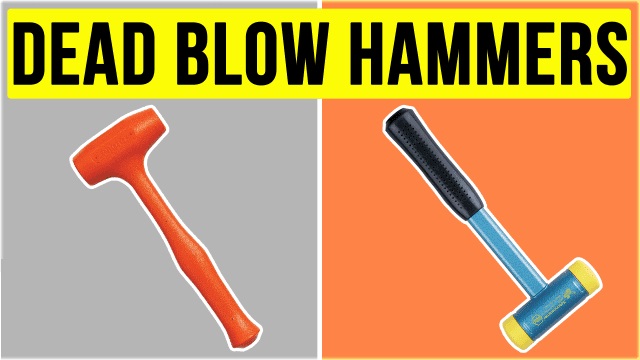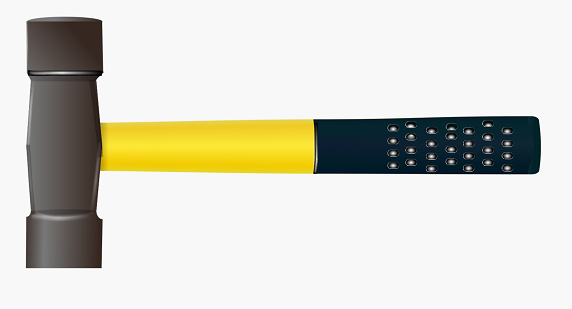What is a Dead Blow Hammer?
A dead blow hammer is a type of mallet designed for minimizing damage to surfaces and reducing the rebound effect commonly associated with traditional hammers. It features a distinctive construction that includes an internal cavity filled with materials like sand, lead shot, or steel shot. This filling absorbs and redistributes the energy generated by the striking face, ensuring a more controlled and less damaging impact.
Key characteristics of dead blow hammers include:
- No Bounceback: The internal filling absorbs the energy of the strike, preventing the hammer from bouncing back upon impact. This is particularly useful when working in confined spaces or when precision is crucial.
- Non-Marring: Dead blow hammers are designed to minimize damage to the struck surface. This makes them suitable for tasks where preventing marks or dents is essential, such as woodworking or automotive bodywork.
- Various Head Shapes: Dead blow hammers come in different head shapes, including flat, ball-peen, or even mallet-style faces. The choice of head shape depends on the specific task and the desired impact.
- Materials: The outer shell of a dead blow hammer is typically made of durable materials like polyurethane, rubber, or other non-marring materials. This construction further contributes to surface protection.
- Handle Options: Dead blow hammers may have handles made from materials such as wood, fiberglass, or rubberized grips. The handle design is often ergonomic to improve user comfort and control.
- Versatility: These hammers are versatile tools used in a variety of industries, including woodworking, metalworking, automotive repair, construction, and maintenance tasks. Their ability to deliver controlled strikes makes them valuable in precision work.
- Reduced Vibration: The internal filling not only reduces bounce but also dampens vibrations. This can be beneficial for the comfort of the user and may reduce the risk of repetitive strain injuries over prolonged use.
Dead blow hammers are favored by professionals and DIY enthusiasts alike for tasks that require controlled force without the risk of damaging materials or causing injury. Their unique design and characteristics make them essential tools in a toolkit for a wide range of applications.
What are Dead Blow Hammers Used For?
Dead blow hammers are versatile tools that find applications in various industries and tasks. Their unique design, featuring an internal striking face filled with materials like sand or steel shot, reduces rebound and minimizes the risk of marring surfaces. Here are some common uses for dead blow hammers:
- Woodworking:
- Precise Joinery: Dead blow hammers are ideal for tasks requiring controlled strikes, such as seating joints and dovetails without damaging the wood.
- Surface Protection: The non-marring feature of dead blow hammers is crucial when working with delicate wood surfaces or finishes.
- Metalworking:
- Shaping Metal: Dead blow hammers are effective for shaping and forming metal without leaving marks or dents.
- Removing Dents: They are used to remove dents from metal surfaces without causing additional damage.
- Automotive Repairs:
- Panel Straightening: Dead blow hammers are commonly used in auto body repair to straighten panels and remove dents without causing further damage.
- Assembly and Disassembly: They are employed in automotive assembly and disassembly tasks, providing controlled force without the risk of damaging parts.
- Construction and Carpentry:
- Assembly of Components: Dead blow hammers are used in construction for assembling components, such as driving in fasteners or seating parts together.
- Precision Framing: Carpenters use dead blow hammers for precise framing work, ensuring a snug fit without damaging the materials.
- Machinery Maintenance:
- Gear and Bearing Installation: When installing gears or bearings, dead blow hammers provide the necessary force without damaging these precision components.
- Aligning Parts: In machinery maintenance, dead blow hammers are valuable for aligning and adjusting parts without causing undue stress.
- Flammable Environments:
- Safety in Spark-Sensitive Areas: The non-sparking nature of dead blow hammers makes them suitable for use in environments where sparks could be hazardous, such as in the presence of flammable gases.
- DIY Home Projects:
- Furniture Assembly: Dead blow hammers are handy for assembling furniture, ensuring that components are driven together without leaving marks.
- Home Repairs: Whether you’re hanging pictures or making minor repairs, the controlled force of a dead blow hammer is beneficial in a variety of household tasks.
- Concrete Forming:
- Forming and Shaping: Dead blow hammers are used in concrete work to shape and form molds without damaging the forms or the poured concrete.
- General Striking Applications:
- Striking Chisels: Craftsmen use dead blow hammers for striking chisels, providing the necessary force for cutting or carving without the risk of overstriking.
Dead blow hammers are valued for their ability to deliver controlled and powerful strikes without causing damage, making them indispensable in a wide range of professional and DIY applications across different industries.

